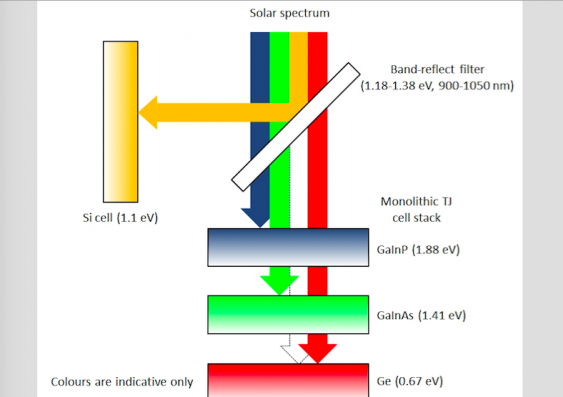A team of researchers at the University of New South Wales has broken its own record for photovoltaic efficiency. This advance comes through use of what are called “multi-junction” solar cells that use prisms to split sunlight across its spectrum, to hit multiple receptors targeted at different wavelengths.

A 2-D diagram of how the prism spectrum splitter mini-module works.
Multi-junction solar cells of this type are unlikely to find their way onto the rooftops of homes and offices soon, as they require more effort to manufacture and therefore cost more than standard crystalline silicon cells with a single junction. But the UNSW team is working on new techniques to reduce the manufacturing complexity, and create cheaper multi-junction cells.
However, the spectrum-splitting approach is perfect for solar towers, like those being developed by Australia’s RayGen Resources, which use mirrors to concentrate sunlight which is then converted directly into electricity.
So this is currently an advancement for centralized solar power, but for all I prefer distributed models, some centralized, high-output generators will certainly be needed if we’re to transition to a society that relies more heavily on electricity for things like transportation.

… solar towers… which use mirrors to concentrate sunlight which is then converted directly into electricity.
If by “directly” you mean “concentrated sunlight heats a fluid which drives a turbine which …” – or have I missed some other developments in generation technology?
Good news and a lot of recent progress in this area.
Battery style storage is, from what I gather currently one of the remaining obstacles which solar panel engineers are working on too.
@Pierce R. Butler
I believe it refers to this from earlier in the article I linked:
There have been a number of efforts to concentrate sunlight on photovoltaic cells in order to get the same power generation from a smaller solar cell. The other methods I’ve seen have used lenses. Basically the idea is that lenses and mirrors are cheaper to make than solar cells, so if you have a setup that can increase the power generated that way, it’ll be more cost-effective.
Pierce R. Butler @1
I don’t think that Solar panels have ever relied on heating a fluid to convert it to gas and drive a turbine. Not an expert on the subject, but page from NASA explaining the photovoltaic effect helped me out.
Of course if you knew all that and I misinterpreted your comment, apologies.
@usagichan
I believe he’s referring to concentrated solar thermal power: https://en.wikipedia.org/wiki/Concentrated_solar_power
It’s been (sigh) quite a while since I followed solar tech developments closely, but what I learned way back then was that, given that the way the sun follows varying curved paths, reflectors are typically less cost-effective than simply expanding collector size – except for specialized high-temperature uses.
Since these folks seemingly work on (ahem) blue-sky research projects, the time-to-payback factor rightly does not matter so much, particularly in the early phases of a given effort. Certainly the advanced optics of wavelength-splitting and -optimization go far over my head – if they’re getting 40%(!) conversion efficiency, more power to (and from) them!
Abe D has it right at # 5 – I have been under the impression that solar-tower-&-reflector-array work has little application beyond thermal uses. Making such apparatus for PV purposes immediately brings two questions to my little mind:
1) Doesn’t the sophisticated 3-D manipulation of each reflector necessary to concentrate the energy cost more than an equivalent area of immobile collector surface?
2) How do they keep the inevitable heat build-up in the PV area from baking the accompanying electronics, and when can I get a laptop with such protection?
All good questions.
In terms of reflector effectiveness, my understanding is that the current standard for solar thermal towers is to have an array of small mirrors on the ground that move to keep sunlight focused on the furnace throughout the day. They’re hooked up to sensors around the edges of the whole setup.
In terms of concentrating light on a collector, I guess it depends on how it’s done. I don’t really know the details in terms of preventing overheating and so on – this article is honestly the first I’d heard of multi-junction solar cells.